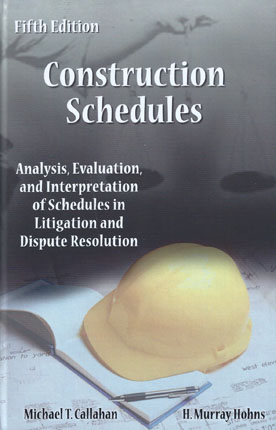We will be closed from 5pm Thursday 17th April for the Easter Bank Holidays, re-opening at 8.30am on Tuesday 22nd April. Any orders placed during this period will be processed when we re-open.

All parties on the building team, including the most important of all, the owner, as well as courts and administrative boards throughout the United States, must now deal with construction schedules as an integral part of the construction process.
Yet there still is little uniformity in scheduling methods. Specifications, understanding, use, and even the language differ. Logic demands that schedules be recognized in the litigation process the same way that schedules are used in the construction process. Indeed, the same logic assumes a uniform understanding of scheduling concepts which is often lacking in the construction industry.
However, courts and contract review boards consistently apply scheduling techniques to construction litigation far differently than those in the construction industry do. The typical judge, board or arbitrator often elevates the place and portent of a schedule far beyond that which is done in the real world of the construction participants.
At the same time, the judge, board or arbitrator will not understand what the schedule means, and the telling nuances by which the network analysis quality is to be measured will be far beyond their understanding and their patience.
This book is not a text on how to produce a schedule. Rather, it was written to explain the manner in which a schedule should be used and interpreted. It is designed for the advanced student and industry practitioner to use in the every-day, real world of presenting and resolving time-related construction disputes.
Any large project is a world of its own, in which the costs of scheduling and increasing productivity are insignificant when compared to the project's labor and equipment costs and what happens when the work falls behind and completion is delayed. The costs of not scheduling are beyond comprehension, yet little scheduling with any degree of quality is done, nor is any real thought given to productivity improvement.
Those in charge typically react to what happens instead of planning what should happen and then managing activities to make it happen.
The serious student of the construction industry should find this work indispensable: Contractors and their attorneys can see how the law courts have interpreted and applied their “tool” of scheduling and alternately can revise the manner in which they develop and use schedules or in future disputes they can show courts where past decisions were in error.
Trial lawyers litigating construction cases may use the text in much the same way. Past case law can be used to support present positions or the authors' comments can be heeded to influence or change court interpretation of schedules in the past.
Contractors can learn the importance of scheduling and see the errors others have made in developing a network diagram or the schedule technique chosen on the job.
Construction managers should see and thus no longer pursue much of the folly they now permit and promote in their scheduling work and their marketing efforts.
Design builders should come away from this book with far better appreciation that they owe a higher depth of coordination and supervision to those they retain on the work since the design builders are responsible for design, its details, submittal review, and scheduling construction and subcontractor work; this work being generally priced or budgeted before the work scope, space availability and dimensional problems are sufficiently known.
Architects and engineers writing scheduling clauses in the contracts between the contractor and owner (and between designer and owner) may use the illustrated clauses as a guide and perhaps even accept the authors’ suggestions and modify the clauses to (in theory) eliminate confusion in interpreting the schedules.
Designers called upon to resolve disputes which involve schedules between owners and contractors may use the book to assist in reaching an accurate and unbiased decision.
Lawyers drafting contracts between owner and contractor or owner and designer may use the text in a manner similar to architects and engineers. Lawyers can recommend that owners stop publishing contracts that tell contractors and designers how to schedule the work; Indeed, the authors emphasize that owners in their contract specifications should bar the schedule as a contract document, and put the entire risk of progress and on-time completion on those parties that have that responsibility by tradition and should by contract. The book covers how any owner can prepare contract language to largely, if not totally, eliminate delay claims.
Students of all disciplines, professions and ages will be able to use this book as a guide to learning the proper and improper ways to apply schedules.